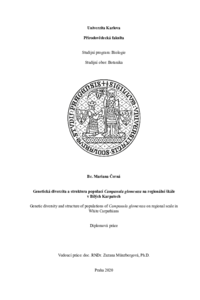Genetická diverzita a struktura populací Campanula glomerata na regionální škále v Bílých Karpatech
Genetic diversity and structure of populations of Campanula glomerata on regional scale in White Carpathians
diplomová práce (OBHÁJENO)

Zobrazit/
Trvalý odkaz
http://hdl.handle.net/20.500.11956/122160Identifikátory
SIS: 198528
Kolekce
- Kvalifikační práce [21483]
Autor
Vedoucí práce
Oponent práce
Kotilínek, Milan
Fakulta / součást
Přírodovědecká fakulta
Obor
Botanika
Katedra / ústav / klinika
Katedra botaniky
Datum obhajoby
2. 9. 2020
Nakladatel
Univerzita Karlova, Přírodovědecká fakultaJazyk
Čeština
Známka
Velmi dobře
Klíčová slova (česky)
Campanula glomerata, genetická diverzita, mikrosatelity, fragmentace stanoviště, kontinuita travních porostů, genový tok, environmentální faktoryKlíčová slova (anglicky)
Campanula glomerata, genetic diversity, microsatellites, habitat fragmentation, continuity of grasslands, gene flow, environmental factorsFragmentace stanovišť může negativně ovlivnit populace druhů kvůli snížené genetické diverzitě a zvýšené diferenciaci populací v důsledku izolace stanovišť, snížené velikosti populací a narušení genového toku. Řada druhů trpí fragmentací stanovišť a izolovaností a Campanula glomerata je dobrým příkladem druhu, který je na mnoha místech znatelně na ústupu kvůli změnám v obhospodařování krajiny. Otázkou je, jak modelový druh C. glomerata reaguje na tyto změny a jestli se tyto změny projeví v genetické diverzitě a struktuře populací. Cílem této práce je tedy zjistit míru genetické diverzity a odkrýt genetickou strukturu populací modelového druhu C. glomerata na malé regionální škále v Bílých Karpatech. Tento systém nám umožní srovnat populace ze dvou odlišných regionů, které byly různou mírou zasaženy zemědělskou intenzifikací a fragmentací v minulém století. Jde o jihozápadní a severovýchodní část regionu, které se od sebe liší historií managementu v krajině, kontinuitou lučních porostů, druhovým složením a přírodními podmínkami. Pro tento účel jsem vyvinula a optimalizovala celkem 16 použitelných mikrosatelitových markerů, z nichž 4 pochází od příbuzných druhů rodu Campanula a 12 bylo pro druh C. glomerata vyvinuto nově. Výsledky naznačují, že nedávná fragmentace stanovišť nevedla k významné ztrátě...
Habitat fragmentation can adversely affect species populations due to reduced genetic diversity and increased population differentiation due to habitat isolation, reduced population size, and disruption of gene flow. Many species suffer from habitat fragmentation and isolation, and Campanula glomerata is a good example of a species that is noticeably declining in many places due to changes in landscape management. The question is how the model species responds to these changes and whether is the change are reflected in genetic diversity and population structure. The aim of this work is to determine the degree of genetic diversity and to reveal the genetic structure of populations of the model species C. glomerata on a small regional scale in the White Carpathians. This system will allow us to compare populations from two different regions that have been affected to varying degrees by agricultural intensification and fragmentation in the last century. It is a southwestern and northeastern part of the region, which differs from each other in the history of management in the landscape, but also in the continuity of meadows, species composition and environmental conditions. For this purpose, I developed and optimized a total of 16 usable microsatellite markers, 4 of which come from related species of...
